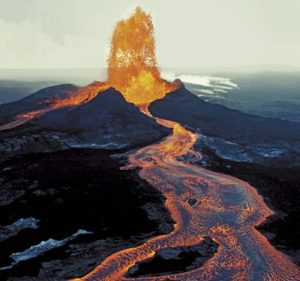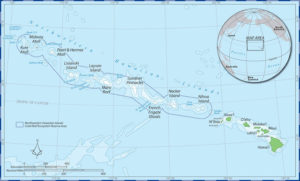Pele
Pele is the Hawaiian Volcano Goddess. Like many goddesses, she is both creator and destroyer. She built the entire island chain, is now busy making the Big Island bigger, and is working on a new one that is just a seamount today. It’s interesting most everyone in Hawaii believes in her and are resigned to her moods.
She is really in a mood now, both building and destroying. If you haven’t been following the eruption, go to the USGS website or Facebook feed and watch. We have a unique opportunity to watch new land being created. Broadly there are two main types of volcanos – shield volcanos like Kilauea, and stratovolcanos like the ones on our west coast. Mt. St. Helens is the latest example of what stratovolcanos can do if they have a mind to.
There are some minor ones, but those are the big two. Their difference stems from the magma rising from the interface of the crust and the mantle. Two types of magma create volcanos. Stratovolcanos have felsic magma, derived from the lighter crust beneath continents. The most common felsic rock is granite. Shield volcanos are made of basalt, a mafic rock making the ocean floor.
Stratovolcanos tend to form those big conical mountains people like to view or climb. All the Cascades are stratovolcanos, Mt. Rainier being the most famous. Felsic magma is less viscous and as it rises from the magma chamber the gasses are trapped until the pressure exceeds the pressure of the overlying rock. Then it blows. When Mt. Hood blows, goodbye to Eugene. When Rainier blows, goodbye Seattle and Tacoma.
Mafic magma is more dense and less viscous and tends to flow out and spread with less violence if you can call a 300 foot high plume of 2000 degree lava less violent. All that black lava spreading over the land is violent, it’s just not as explosive. It’s gas bubbles that cause explosions. As magma rises, there is less pressure, allowing gas bubbles to expand and some water becomes gas. If the bubbles can move through cracks and voids in the magma it rises to the surface without big explosions. If the magma is more homogeneous, the gas stays in place until its pressure exceeds the weight of the overlying magma and things go boom.
We are on a big ball of stuff. The core tends to be iron, but there are radioactive elements there and when they decay, they give off heat. So, we are living on a ball of really hot stuff, made of layers with different density. Felsic rock continents are less dense than the mafic stuff under them. They float on mafic magma much like an iceberg in the sea. Most of the continent’s mass sits down in the mafic magma. You can’t call deep magma liquid, it is more plastic, but it moves. Hotter stuff rises through the cooler stuff above and sometimes makes it all the way.
It can rise into the mid ocean ridges, ooze out and spread. A tectonic plate is forming. As it moves away from the ridge, it runs into the lighter continent and heads back down, but not without making a mess on the continent. There is the origin of stratovolcanos. Mountain ranges and volcanos are mostly on the coasts.
There are other place where magma surfaces called hot spots. A plume of magma rises from the deep, belching and vomiting as it gets to the surface. Hawaii, Iceland, and Yellowstone are hot spots. The Hawaiian hot spot is out there in the Pacific where mafic magma lives, so shield volcanos form. Lava flowing created the islands. Yellowstone is in felsic rock country on a continent so periodically it blows up. Really blows up, laying waste to hundreds of square miles. If it happens, Denver is toast.
Tectonic plates move over the hot spots, leaving a chain of Hawaiian islands. The Yellowstone hot spot has left a trail across Idaho. Much of that track is composed of mafic magma that found its way up as the continent travelled west. Lots of basalt there, forming the Snake River Gorge.
Don’t expect all this planetary action to slow down anytime soon. There are still radioactive elements decaying and the rock doesn’t cool off very fast. We have to resign ourselves to living on a big stirred up rock that will shove things around and pump magma out on the ground. Thus, we must give Pele her due. She is our neighbor and will do what she will.



